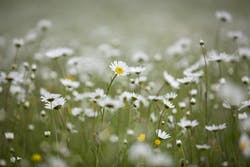my top wild flower mixes and garden-worthy varieties
 Wild flowers were my first love in the plant world. Here are my favourite varieties, that flower for months, not just a few fleeting weeks, and are possible to grow in your own back garden. For instructions on how to create a mini wild flower meadow, and to grow wildflower seedlings, see our 'how-to' articles and videos.
Wild flowers were my first love in the plant world. Here are my favourite varieties, that flower for months, not just a few fleeting weeks, and are possible to grow in your own back garden. For instructions on how to create a mini wild flower meadow, and to grow wildflower seedlings, see our 'how-to' articles and videos.
My Top Wildflower Mixes
- Wildflower Meadow Mix
I want my patch to be a regular and reliable food source for the birds and the bees. That’s what you’ll get with this beautiful selection of my favourite easy and reliable perennial wild flowers.
- Pictorial Meadows - Classic Annual Mix: The jolly and colourful Classic Annual Mix gives you a fantastic flowery meadow from June until October, starting out with white, blues, pinks and reds, turning to reds, orange and yellow in the autumn.
- Pictorial Meadows - Pastel Annual Mix: The Pastel Mix gives you beautiful ‘strawberries & cream’ mix of white and pink with a scattering of clear blue cornflower. The show starts with Bishop's Flower and Shirley Poppy, with white Cosmos fast emerging and flowering long and hard right into late autumn.
My top 10 garden-worthy wildflowers
- Agrimony - I love Agrimony for its verticality, its tall, tapering spires of primrose yellow and it looks good from May, when the flower spikes first draw out in tight bud, until late autumn. Hoverflies in particular seem to love it.The seed sets in late summer, so if you want Agrimony leave grass cutting as late as you can.
- Betony - Betony flowers for months, coming into bloom with Oxeye Daisies and Self-heal in early summer, and still going strong with Agrimony well into autumn. As one of the dead-nettles, its flowers are packed full of nectar and its intense magenta-colour draws them in.
- Devil's-bit Scabious - I have great affection for this plant because it is all over the sweetest areas of grass on the west coast of Scotland, where I spent a lot of time during my childhood and still go now. There is always plenty of it in the dry sunny spots where you set up camp to have a picnic. Like other members of the Teasel family, it is rich in pollen and nectar and it is the larval food plant of the Marsh Fritillary butterfly and the Narrow-bordered Bee Hawk-moth.
- Dyers Greenweed - This is a wild flower with real resonance for me, as it was one of the first interesting plants we found when we arrived at Perch Hill 17 years ago. It’s one of the few showy wild flowers specific to acid meadows and longer grasslands and loved by all our pollinators.
- Field scabious - The largest scabious in the British Isles, with bumper-sized flowers, in the palest, softest mauve. It flowers for months, right through the summer, and has high-quality nectar for butterflies and bees. Many insects home in on it above other chalk meadow flowers, and finches and linnets love its seed.
- Great Burnet - A tall, upright plant with flowers that look like the crunchy blue, sugar-coated variety of Liquorice Allsorts, except that these are not blue but a deep purple-claret, turning green below. This inflorescence is not one flower but many, and so rich in nectar and pollen.
- Greater Knapweed - Big and showy, like a cross between a cornflower and a thistle, with whiskery petals in a whorl. It is a valuable nectar source for insects and a favourite flower of butterflies, including the Marbled White and Dark Green Fritillary.
- Lady’s Bedstraw - This is one of my favourite wild plants. Individually, it has tiny, delicate flowers, but lots of them together make the ground look as though it is puffing with yellow, sulphurous smoke. It smells delicious, too – like hay mixed with honey – and the scent remains even when it is dried. It’s loved by all butterflies and bees.
- Meadow Crane’s-bill - This is one of our showiest roadside and grassland plant, with the largest flowers of our native crane’s-bills. It flowers for ages and is very valuable to insects, the paler radiating veins on the petals guiding bees to the nectar within.
- Tufted Vetch - Its purple pea flowers, ageing to blue, adding bright dashes of colour to the meadow carpet. I love the way that it mounds up like surf on a beach, one great arm of a plant folding itself up and over other things, so that you get great heaps of it. It also has a long flowering season and many flowers and is particularly brilliant for bees.
Ox-eye Daisy and Common Knapweed are also lovely, but can be take-over agents so should be sown in lesser quantity. The wild-flower meadow expert Charles Flower (who has written a very useful book, ‘Where have all the flowers Gone’) describes how he fenced off an area of newly sown grass with wild-flower mix on his farm in Wiltshire. He cut and managed the fenced area but left a small strip outside the fence unmanaged. After ten years, instead of the fifteen species of wild flower originally introduced, there were just three, including both of these.



